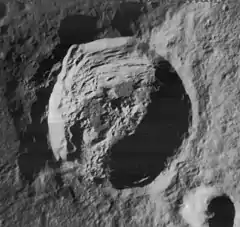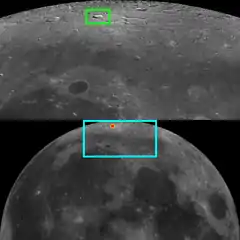Anaxagoras (crater)
Anaxagoras is a young lunar impact crater that is located near the north pole of the Moon. It lies across the larger and more heavily worn crater Goldschmidt. To the south-southeast is Epigenes, and due south is the worn remains of Birmingham.
 Lunar Orbiter 4 image | |
| Coordinates | 73.48°N 10.17°W |
|---|---|
| Diameter | 51.9 km |
| Depth | 3.0 km |
| Colongitude | 11° at sunrise |
| Eponym | Anaxagoras |


Anaxagoras is a relatively recent impact crater that is young enough to still possess a ray system that has not been eroded by space weathering. The rays from the site reach a distance of over 900 kilometers from the rim, reaching Plato to the south. It is consequently mapped as part of the Copernican System.[1]
The crater interior has a relatively high albedo, making it a prominent feature when the Moon is nearly full. (The high latitude of the crater means that the Sun always remains close to the horizon even at maximum elevation less than a day after Full Moon.) The interior walls are steep and possess a system of terraces. The central peak is offset from the crater midpoint, and joins a low range across the crater floor. In fact, it appears that some of the central peak material has landed outside the crater rim.[2]
Satellite craters
By convention these features are identified on lunar maps by placing the letter on the side of the crater midpoint that is closest to Anaxagoras.
| Anaxagoras | Latitude | Longitude | Diameter |
|---|---|---|---|
| A | 72.2° N | 6.9° W | 18 km |
| B | 70.3° N | 11.4° W | 5 km |
References
- The geologic history of the Moon, 1987, Wilhelms, Don E.; with sections by McCauley, John F.; Trask, Newell J. USGS Professional Paper: 1348. Plate 11: Copernican System (online)
- The geologic history of the Moon, 1987, Wilhelms, Don E.; with sections by McCauley, John F.; Trask, Newell J. USGS Professional Paper: 1348. Figure 3.34. (online)
- Andersson, L. E.; Whitaker, E. A. (1982). NASA Catalogue of Lunar Nomenclature. NASA RP-1097.
- Blue, Jennifer (July 25, 2007). "Gazetteer of Planetary Nomenclature". USGS. Retrieved 2007-08-05.
- Bussey, B.; Spudis, P. (2004). The Clementine Atlas of the Moon. New York: Cambridge University Press. ISBN 978-0-521-81528-4.
- Cocks, Elijah E.; Cocks, Josiah C. (1995). Who's Who on the Moon: A Biographical Dictionary of Lunar Nomenclature. Tudor Publishers. ISBN 978-0-936389-27-1.
- McDowell, Jonathan (July 15, 2007). "Lunar Nomenclature". Jonathan's Space Report. Retrieved 2007-10-24.
- Menzel, D. H.; Minnaert, M.; Levin, B.; Dollfus, A.; Bell, B. (1971). "Report on Lunar Nomenclature by the Working Group of Commission 17 of the IAU". Space Science Reviews. 12 (2): 136–186. Bibcode:1971SSRv...12..136M. doi:10.1007/BF00171763. S2CID 122125855.
- Moore, Patrick (2001). On the Moon. Sterling Publishing Co. ISBN 978-0-304-35469-6.
- Price, Fred W. (1988). The Moon Observer's Handbook. Cambridge University Press. ISBN 978-0-521-33500-3.
- Rükl, Antonín (1990). Atlas of the Moon. Kalmbach Books. ISBN 978-0-913135-17-4.
- Webb, Rev. T. W. (1962). Celestial Objects for Common Telescopes (6th revised ed.). Dover. ISBN 978-0-486-20917-3.
- Whitaker, Ewen A. (1999). Mapping and Naming the Moon. Cambridge University Press. ISBN 978-0-521-62248-6.
- Wlasuk, Peter T. (2000). Observing the Moon. Springer. ISBN 978-1-85233-193-1.
External links
- Exposed Fractured Bedrock in the Central Peak of the Anaxagoras Crater, LRO article, 16 April 2010
External links
 Media related to Anaxagoras (crater) at Wikimedia Commons
Media related to Anaxagoras (crater) at Wikimedia Commons
